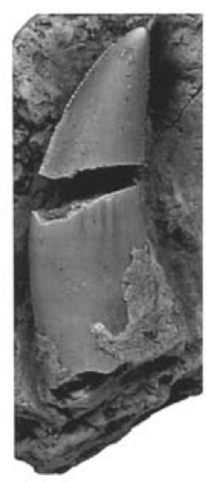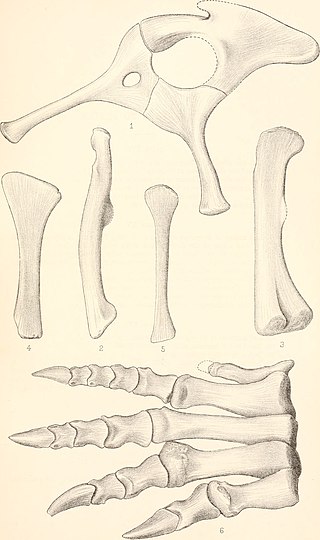
Anchisaurus is a genus of basal sauropodomorph dinosaur. It lived during the Early Jurassic Period, and its fossils have been found in the red sandstone of the Upper Portland Formation, Northeastern United States, which was deposited from the Hettangian age into the Sinemurian age, between about 200 and 192 million years ago. Until recently it was classed as a member of Prosauropoda. The genus name Anchisaurus comes from the Greek αγχιanchi-; "near, close" + Greek σαυρος ; "lizard". Anchisaurus was coined as a replacement name for "Amphisaurus", which was itself a replacement name for Hitchcock's "Megadactylus", both of which had already been used for other animals.

Thecodontosaurus is a genus of herbivorous basal sauropodomorph dinosaur that lived during the late Triassic period.

Melanorosaurus is a genus of basal sauropodomorph dinosaur that lived during the Late Triassic period. A herbivore from South Africa, it had a large body and sturdy limbs, suggesting it moved about on all fours. Its limb bones were massive and heavy like the limb bones of true sauropods.

Riojasaurus was a herbivorous sauropodomorph dinosaur named after La Rioja Province in Argentina where it was found in the Los Colorados Formation in the Ischigualasto-Villa Unión Basin by José Bonaparte. It lived during the Late Triassic and grew to about 6.6 metres (22 ft) long. Riojasaurus is the only known riojasaurid to live in South America.

Massospondylus was a genus of sauropodomorph dinosaur from the Early Jurassic. It was described by Sir Richard Owen in 1854 from remains discovered in South Africa, and is thus one of the first dinosaurs to have been named. Fossils have since been found at other locations in South Africa, Lesotho, and Zimbabwe. Material from Arizona's Kayenta Formation, India, and Argentina has been assigned to the genus at various times, but the Arizonan and Argentinian material are now assigned to other genera.

Isanosaurus is an extinct genus of sauropod dinosaur from Thailand. It was originally dated to approximately 210 million years ago during the Late Triassic, which would make it one of the oldest known sauropods. Its age was later considered uncertain, and may be Early Jurassic or even as young as Late Jurassic. The only species is Isanosaurus attavipachi. Though important for the understanding of sauropod origin and early evolution, Isanosaurus is poorly known. Exact relationships to other early sauropods remain unresolved.

Lufengosaurus is a genus of massospondylid dinosaur which lived during the Early Jurassic period in what is now southwestern China.

Antetonitrus is a genus of sauropodiform dinosaur found in the Early Jurassic Elliot Formation of South Africa. The only species is Antetonitrus ingenipes. Sometimes considered a basal sauropod, it is crucial for the understanding of the origin and early evolution of this group. It was a quadrupedal herbivore, like its later relatives, but shows primitive adaptations to use the forelimbs for grasping, instead of purely for weight support.

Blikanasaurus is a genus of sauropodomorph dinosaur from the late Triassic of South Africa. The generic name Blikanasaurus is derived from Greek, meaning "lizard from Blikana". The species name cromptoni is taken from the surname of A.W. "Fuzz" Crompton, an American paleontologist who led numerous field expeditions in Elliot Formation outcrop localities in South Africa. Blikanasaurus is only known from partial hindlimb bones that were recovered from the lower Elliot Formation (LEF) in the Eastern Cape.

Avalonianus is a highly dubious and possibly invalid genus of archosaur from the Late Triassic Westbury Formation of England. It was first described in 1898 by Harry Seeley with the name Avalonia, but that name was preoccupied, so Oskar Kuhn renamed it in 1961, albeit with no epithet. It was thought to be a prosauropod, but later analysis revealed it was actually a chimera, with the original teeth coming from a non-dinosaurian ornithosuchian, and later-referred post-cranial prosauropod remains. The only sufficient remains attributable to Avalonianus are several now lost fossil teeth from the chimera that were referred to Archosauria.

Euskelosaurus is a sauropodomorph dinosaur from the Late Triassic of South Africa and Lesotho. Fossils have only been recovered from the lower Elliot Formation in South Africa and Lesotho, and in one locality in Zimbabwe.

Coloradisaurus is a genus of massospondylid sauropodomorph dinosaur. It lived during the Late Triassic period in what is now La Rioja Province, Argentina. It is known from two specimens collected from the Los Colorados Formation of the Ischigualasto-Villa Unión Basin.

Gryponyx is an extinct genus of massopod sauropodomorph known from southern Free State, central South Africa.
Chinshakiangosaurus is a genus of dinosaur and probably one of the most basal sauropods known. The only species, Chinshakiangosaurus chunghoensis, is known from a fragmentary skeleton found in Lower Jurassic rocks in China. Chinshakiangosaurus is one of the few basal sauropods with preserved skull bones and therefore important for the understanding of the early evolution of this group. It shows that early sauropods may have possessed fleshy cheeks.

Teratosaurus is a genus of rauisuchians known from the Triassic Stubensandstein of Germany. It is estimated to be 6.2 meters (20.35 ft) long.

Picrodon is the name given to a genus of archosaur, possibly a sauropodomorph dinosaur, from the Rhaetian of England which was possibly synonymous with the dubious archosaur Avalonianus. The type, and only species, P. herveyi, was named in 1898.

Anchisauria is an extinct clade of sauropodomorph dinosaurs that lived from the Late Triassic to the Late Cretaceous. The name Anchisauria was first used Haekel and defined by Galton and Upchurch in the second edition of The Dinosauria. It is a node-based taxon containing the most recent common ancestor of Anchisaurus polyzelus and Melanorosaurus readi, and all its descendants. Galton and Upchurch assigned a family of dinosaurs to the Anchisauria: the Melanorosauridae. The more common prosauropods Plateosaurus and Massospondylus were placed in the sister clade Plateosauria.

The Melanorosauridae were a family of sauropodomorph dinosaurs which lived during the Late Triassic and Early Jurassic. The name Melanorosauridae was first coined by Friedrich von Huene in 1929. Huene assigned several families of dinosaurs to the infraorder "Prosauropoda": the Anchisauridae, the Plateosauridae, the Thecodontosauridae, and the Melanorosauridae. Since then, these families have undergone numerous revisions. Galton and Upchurch (2004) considered Camelotia, Lessemsaurus, and Melanorosaurus members of the family Melanorosauridae. A more recent study by Yates (2007) indicates that the melanorosaurids were instead early sauropods.
The Westbury Formation is a geological formation in England, one of the Penarth Group. It dates back to the Rhaetian. The formation is named after the village of Westbury-on-Severn in Gloucestershire. The remains of a giant shastasaurid and dinosaurs are known from the formation.

Meroktenos is a genus of basal sauropodomorph dinosaur that lived during the Late Triassic period of what is now Lesotho.



























